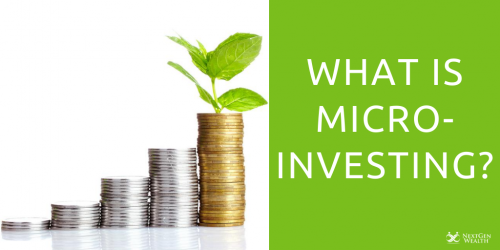What is Micro Investing?
Typically, if you want to become an investor, you need sufficient capital to make any headway. These days, however, it’s never been easier to make your money work for you, thanks to various investing apps and opportunities. 
If you’re short on funds, you might think that investing is out of reach. You’d be wrong. Thanks to the growing trend of micro-investing, anyone with a bank account can get started.
Today we’re going to discuss the ins and outs of micro-investing so that you can take full advantage of its benefits. If you want to become an investor, now is the perfect time.
What is Micro-Investing?
When buying stocks, you can either purchase a whole unit or a fraction of one. The ability to buy fractional shares has opened up investing to many people who would otherwise not have enough funds to get into the stock market.
Micro-investing is when you purchase fractional shares for a low price. In most cases, a micro-investment can be as low as five dollars. Best of all, because software and apps handle these transactions, you don’t have to be a technical genius to get started.
One of the barriers to traditional investing is the requirement of maintaining a minimum account balance. In most instances, investors have to keep a substantial portion invested at any given time, which can cut into their profit margin.
By comparison, micro-investing doesn’t have that problem. Since most apps require a minimum investment of five dollars, there’s no need to maintain a minimum balance. You can put as little or as much money into your account as you like, and if you need to withdraw funds for any reason, you can do so at any time.
In that way, micro-investing is similar to a savings account. While your money is being put into stocks and shares, it’s much easier to move it around and take it out as necessary. However, unlike a savings account, you’re earning a lot more interest.
The Benefits of Micro-Investing
If you’re only putting away a few dollars at a time, the process may seem a bit counterintuitive. After all, why not save that money and then invest a more substantial sum later on?
There are actually several advantages that come with micro-investing, making it a viable option for everyone. Here are the top reasons why you should be doing it.
No Brokerage Fees
Let’s say that you did decide to save money and buy individual shares of stock at a higher price. For example, perhaps you wait until you have $500 to invest. If you took that money to a brokerage firm, they would charge you a fee for that transaction.
Every time you put cash into the account, you have to pay another fee. Over time, these expenses add up, and they will eat into your bottom line.
With micro-investing, brokerage fees are almost non-existent. Most apps that allow for micro-investing charge nominal rates, such as one dollar per month. As long as you continue to put money away, you likely won’t notice these fees at all.
No Minimum Balance
To open an investment account with a brokerage firm, you have to keep sufficient funds in there at all times. If the market dips and your account goes below the minimum threshold, you have to make up the difference.
The primary issue with this is that you can’t access the funds if you need them. Otherwise, you could incur a penalty. If you don’t have a lot of disposable income, this process may not be viable for you.
Start Earning Interest Immediately
One of the best benefits of micro-investing is that your money starts building right away. If you were to save five or ten dollars at a time with a piggy bank or savings account, you would earn close to zero-percent interest. Even if you were putting cash away to invest later on, it wouldn’t grow until you bought stocks or ETFs.
With micro-investing, your money is earning interest every time you contribute to your account. Since the stock market has an average return of 7 to 10 percent, you could make a lot more money over the same period.
For example, if you saved $50 every month for a year, you would wind up with $600. If you micro-invested that same money, you could wind up with over $700 instead. The best part is that it’s just as easy to micro invest as it is to put cash and change into a piggy bank.
Diversification
When buying fractional shares, you’re actually investing in Exchange-Traded Funds, otherwise known as ETFs. An ETF isn’t an individual stock; instead, it’s a collection of stocks and securities within a specific index (i.e., oil and gas). ETFs operate similarly to mutual funds, but they are traded just like stocks, giving them a distinct advantage.
Since your money isn’t going to an individual stock or company, you don’t have to worry about risky investments. Your cash is going into a diversified portfolio automatically, which can be much more reliable and secure. You can lose funds if the market dips significantly, but since it has always bounced back, you don’t have to worry too much.
Automatic Investment
The best micro-investing apps allow you to automate your contributions. This process is beneficial because it forces you to save without having to think about it.
Apps like Acorns are even more aggressive because they take residual change and invest it for you. For example, if a purchase was $4.25, the software will round up the amount to five dollars and collect the $0.75 difference.
Over time, you can wind up investing a lot more than you would otherwise. Best of all, by rounding up purchases, you don’t notice the withdrawals, but you’re continually adding money to your investment account. After a few months, you could wind up with a decent chunk of change.
Another option is to set up recurring investments. In this case, you put away a set amount of cash every month, such as $50 or $100. This way, you can expedite the saving process without having to remember it every time.
Flexibility
Although micro-investing usually involves amounts lower than twenty dollars, most apps allow you to contribute as much as you want. So, when you have money left over, or you’re able to save a considerable amount, you can put that into your investment account. Overall, micro-investing works for both small and moderate investors who want their money to work harder.
Disadvantages of Micro-Investing
While there are plenty of benefits to this process, it does come with some drawbacks. Here are some factors to consider when signing up for a micro-investing account.
Minimal Returns
If you’re not contributing significant amounts to your fund, then it will grow relatively slowly. Five dollars here and there can take years to build up, and even then, the balance will still be lower than what you might expect.
In many cases, micro-investing is an ideal solution for short-term savings. For example, if you’re putting money away for a significant purchase like a vacation, letting it grow interest for several months or years can give you free cash when you decide to withdraw.
Lack of Control
Typically, micro-investing apps don’t give you much control over the types of shares you purchase. If they do, the variation is generic, such as high-risk, moderate-risk, or low-risk. So, if you want to choose which stocks and ETFs to buy, you will have to get a trading app instead.
Also, if you do have sufficient funds to purchase individual shares, you don’t have that capability with micro-investing. Alternatively, you’ll have to go to a brokerage firm or set up an online trading account.
No Immediate Withdrawals
While micro-investing apps are similar to a high-yield savings account, they do come with a significant caveat: you can’t take money out quickly. Because shares have to be sold, it can take up to five or six business days to withdraw funds from the account. So, if you need fast cash to cover an unexpected bill, you might be out of luck.
Overall, these downsides are not enough to prevent you from starting a micro-investment account, but it’s crucial to understand these limitations. Micro-investing should be considered an additional form of saving, not a replacement for other investment opportunities.
For example, if you’re trying to save for retirement, micro-investing won’t get you there. However, when compared to putting money away in a savings account, this process is usually much better.
Best Apps for Micro-Investing
Now that you understand the basics of micro-investing, how can you get started? We’ve compiled a list of our top apps that can help your pocket change work harder.
Acorns
This app has been growing in popularity lately, thanks to its easy-to-use interface and unique benefits. Acorns works by rounding up purchases to the nearest dollar and adding them to the account in five-dollar increments. To get started, all you have to do is connect a debit card or PayPal account.
In addition to “round-ups,” Acorns also allows you to set up recurring contributions or one-time additions to your account. You can choose when the money is withdrawn from your bank, and you can postpone a monthly contribution if necessary.
Another advantage of this app is the Acorns Later account. You can set up either a Roth or Traditional IRA to help you save for retirement. The best part about Roth IRAs is that you can withdraw contributions tax-free and without penalty. This way, you can build a small nest egg while still having access to your money.
Acorns has two more unique features: Found Money and the Acorns debit card.
Found money works by investing a small portion of your purchases with corporate partners. The best part about this feature is that you’re getting free money from these companies.
For example, if you buy gas from Chevron, you can earn $0.50 per transaction. It’s not much, but it can add up. Now that Acorns is becoming more widespread, the list of partners is growing all the time.
The Acorns debit card is also helpful if you want an alternative to opening a bank account. Not all users qualify for the card, but if your account balance is high enough, you can apply.
Stash
Unlike Acorns, Stash allows users to invest in stocks and ETFs directly. While the platform is all about micro-investing, it’s an excellent resource for beginners. Once you master Stash, you can quickly move onto more complicated apps like Robinhood or Betterment.
Stash makes it easy to understand which ETFs you’re investing in by giving them nicknames. For example, if you want to put money into precious metals, you’ll invest in the All That Glitters ETF. You can also invest directly with high-profile companies like Amazon and Tesla if you like. Stash has over 60 curated ETFs and 200 individual stocks.
Alternatively, you can let Stash make the decisions for you by choosing the type of investments you want (i.e., conservative or aggressive). Thankfully, the app has a lot of learning resources so that you can learn the basics of investing before trying your hand at it.
Robinhood
Theoretically, you could begin your investment journey with Acorns and wind up at Robinhood. Unlike the previous apps, this one allows you more control over your investments. In addition to purchasing fractional shares of ETFs, you can also buy individual stocks.
What set Robinhood apart when it first came out was the fact that there were no trading fees. These days, more and more apps have followed suit, so it’s not as much of a draw as it used to be. Nonetheless, the fact that there is no account minimum is appealing, and it’s the perfect gateway to online trading.
Another unique selling point of Robinhood is that you can trade cryptocurrencies. Most other investment apps don’t allow those kinds of trades.
Contact NextGen Wealth Today
If you’re interested in investing, we can help you get your financial health on track. While micro-investing apps are excellent for getting started, they are only the beginning.
We can help you prepare for the future, whether it’s retirement, family planning or buying property. Call us to find out how we can make your financial goals a reality.


